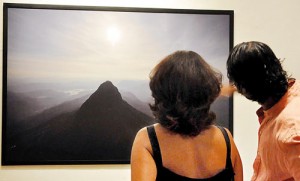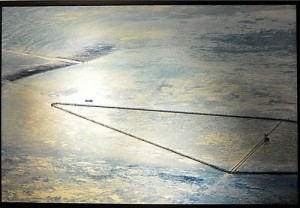Looking down on Mother Lanka
The walls of the gallery are bare, eschewed by the photographs for the office upstairs. I find them there, in the company of photographers

Stunning views: Guests at the exhibition opening take in the photographs. Pix by Indika Handuwala
Dominic Sansoni and Sebastian Posingis and writer Richard Simon. The trio are surrounded by the prints that sit patiently in tidy stacks, nevertheless succeeding in claiming a great deal of space – propping up a wall, overwhelming a long table, always drawing the eye. They come in different sizes, the largest of which is enough to dominate your field of sight. The images are stunning really, rivetingly beautiful, and by the time you read this, will be on display as part of ‘The Island from Above: Aerial Images of Sri Lanka’ at the Barefoot Gallery.
We look through them many times over the course of the next hour, as the men describe their experience: the 20 hours they spent over three weeks, flying across the island; making the decision that their Huey helicopter would, in the words of Simon ‘take the scenic route,’ and allow them to focus on the astonishing natural beauty sprawling out beneath them. “Your perspective literally, as well as metaphorically changes,” says Simon, who accompanied Sansoni and Posingis throughout those weeks, taking notes and reportedly doing some filming of his own, with a small camera strapped to his head.
 One imagines it would be hard to overawe this group. Sansoni, has long been one of the island’s most acclaimed photographers and Posingis, much published, is no slouch himself. By his account, Simon has spent 25 years writing about the nature, culture and history of Sri Lanka. Yet, they all found themselves humbled and inspired by this project. “At the age of 57 – or was it 58 last year? – you would think you know this place,” says Sansoni, punctuating the end of the sentence with an amazed cluck. “It makes me feel rightfully very small. You realise you know nothing.”
One imagines it would be hard to overawe this group. Sansoni, has long been one of the island’s most acclaimed photographers and Posingis, much published, is no slouch himself. By his account, Simon has spent 25 years writing about the nature, culture and history of Sri Lanka. Yet, they all found themselves humbled and inspired by this project. “At the age of 57 – or was it 58 last year? – you would think you know this place,” says Sansoni, punctuating the end of the sentence with an amazed cluck. “It makes me feel rightfully very small. You realise you know nothing.”
The exhibition began as ‘Sri Lanka: The Island from Above,’ a book commissioned by the Access Group of Companies to celebrate their 25th year as a business enterprise. (A commercial version should become available by the end of this year.) It was the client’s generous decision to issue what amounted to a carte blanche to the photographers that enabled a project that Sansoni and Posingis have long dreamed of undertaking. Simon was recruited to write an introduction. He produced just under 12,000 words that describe those weeks, complete with exquisite, informed descriptions of the physical geography of the island, interspersed with oddments from the history of aviation and aerial photography and brief meditations on Sri Lankan culture and its ancient civilisation.
The craft that took them up was once a battlefield ambulance – it would fly so low that jungle foliage would have to be cleaned off its landing gear after each run, writes Simon. Sansoni confesses:“I don’t like flying…stuck in this piece of metal up in the air, with one fan on top.” But the views were unrivalled. Both photographers crowded to one side, allowing them to better agree on where they wanted to go as Sansoni communicated with the pilot. A sophisticated GPS watch tracked their flight path across the island – they circled only rarely, working quickly and running on instinct.
Sometimes, they will hear the result looks a little hazy in one picture or the sea ought to be made bluer. That there has been almost no photo-shopping is intentional. “For us it’s a bit of a point that this is what the island looks like at the moment,” says Posingis, who wanted to create a record that would only gain in value as the years passed.
Looking back, some of his favourite images are from the series taken at Adam’s Bridge. “You don’t know if you were up or down, it was a very hazy, surreal place.” For Sansoni it is the burnt forests and the chena lands;the fish traps in the Puttalam lagoon are a new obsession, the salt pans could pass for stunning abstract art. Even those who live in these places were astonished by the beauty of the landscape around them. In Tissa, as the photographers went through their routine “deep electronic debriefing,” Simon remembers watching locals gather around the laptop screens in fascination. Sometimes the whole staff of the small hotels they stayed in would be there watching as images were transferred, saved and indexed. “Some of the comments I heard then were fabulous,” says Simon.
Looking down from the Huey, people are specks on the beach, a bobbing dot in an ocean whose vast expanse is turned silver by the Sun.Some things the cameras do not capture, but leave to Simon’s words, such as the record of those who live along the fringes of the forests.
Many are outcasts and refugees from their communities, and only some make a living through criminal enterprise. Simon writes of them: ‘The margins of Lanka’s great southern forests are peopled by the ruined, the shamed, the mad, the lovelorn, the hopelessly indebted, the maimed or disfigured and the irremediably meek. The boundaries of Yala National Park are the nearest thing Sri Lanka possesses to a frontier; and frontiers attract misfits, even when there are no fortunes to be made on them.’ While this tome is dedicated to the island’s natural beauty, it is clear there is material enough for many books.
“Those three weeks were amongst the most memorable of my life,” Simon tells the Sunday Times, now.“I will absolutely never forget what I saw, I’ve said this in the book, but I’ll repeat it anyway. This country isn’t just beautiful, though it is that, it is incredibly beautiful, it is also incredibly various,” he says. “The scenery changes every five minutes. It never repeats itself, not once.”
Their new knowledge of all this beauty has kindled a hope that it will contribute, in even the smallest way, to inspiring Sri Lankans to protect what remains of the country’s remarkable biodiversity. The Huey flew over earth marred by illegal dredging, cannabis plantations and illicit gem-mining operations, and more mundanely, ugly examples of urbanisation. For Simon it is an indication of an ongoing battle and he hopes talking about it will spur people to action: ‘Sights like this are symbolic of the struggle being waged on the ground – the struggle between those who have made it their life’s work to preserve the timeless, storied beauty of this island and those who number it among the sacrifices to be made in the name of prosperity.’
The exhibition of photographs continues until March 8 at the Barefoot Gallery


